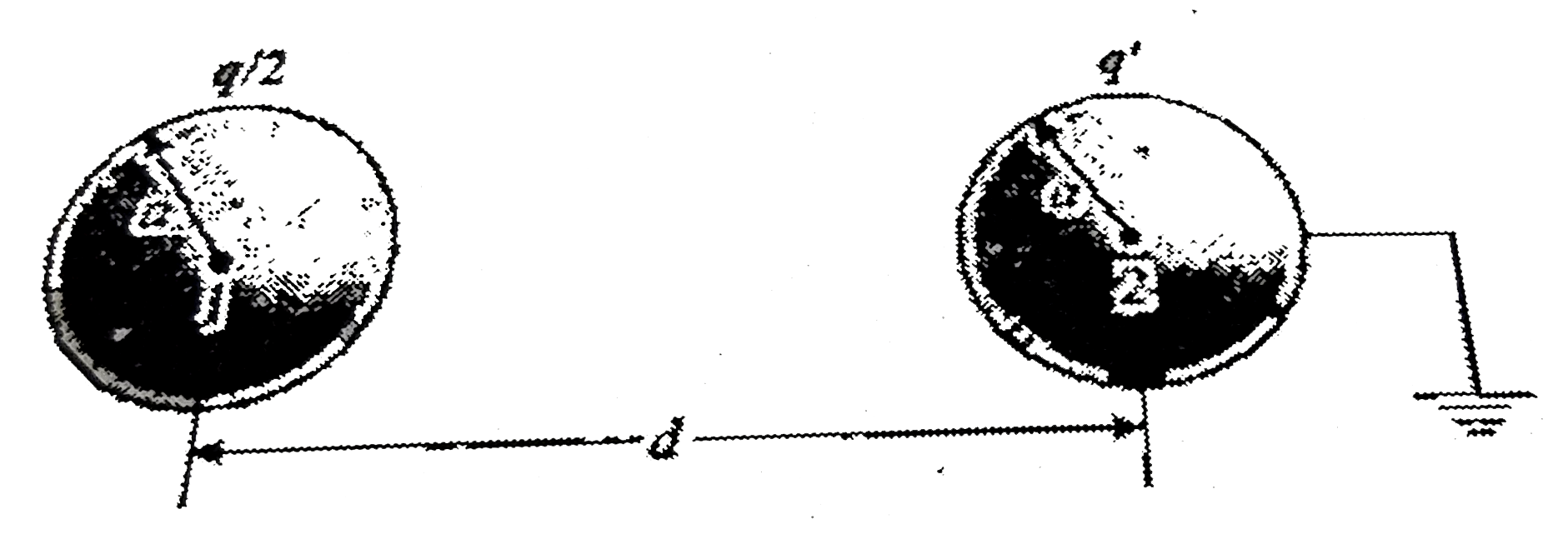A conducting sphere of radius 10 cm is charged to 10μC. Another uncharged sphere of radius 20 cm is allowed to touch it for some time. After that, if the spheres are separated , then surface density of charges on the spheres will be in the ratio ofSolution in Marathi
1:4
1:3
2:1
1:1
Step by step video & image solution for A conducting sphere of radius 10 cm is charged to 10 muC. Another uncharged sphere of radius 20 cm is allowed to touch it for some time. After that, if the spheres are separated , then surface density of charges on the spheres will be in the ratio of by Physics experts to help you in doubts & scoring excellent marks in Class 11 exams.
Updated on:21/07/2023Topper's Solved these Questions
Similar Questions
Relation between the stopping potential V0 of a metal and the maximum velocity of the photoelectrons is
View SolutionA hammer og mass M falls from height h to drive a pile of mass m into the ground. The hammer makes the pile pentrate in the ground to a distance d, opposition force of penetration is given by -
View SolutionThere are two uncharged identicasl metallic spheres 1 and 2 of radius r separated by a distance d(d>>r). A charged metalllic sphere of same radius having charge q is touched with one of the sphere. After some time it is moved away fom the system. Now, the uncharged sphere is earthed. Charge on earthed sphere is
View SolutionA conducting sphere of radius 10 cm is charged 10 muC . Another uncharged sphere of radius 20 cm is allowed to touch it for some tome. After that if the sphere are separted, then surface density of chsrges, on the spheres will be in the ratio of
View SolutionThere are two uncharged identical metallic spheres of radius a, separated a distance d. A charged metallic sphere (charge q) of sarue radius is brought and touches sphere 1. After some time it is moved away to a far off distance. After this, the sphere 2 is earthed. Find the charge on sphere 2.

View Solution10 सेमि त्रिजिये के चालक गोले पर अज्ञात परिद्धम का आवेश है यदि गोले के केन्देर से 20 सेमि दुरी पर विधुत छेत्र 1.5×103 न्यूटन / कॉलम त्रिजियत अनन्तमुर्खी (radially inward) है तो गोले पर नेट आवेश कितना है
View Solution2 सेमि त्रिजिये के एक गोले पर 2μC आवेश है जबकि 5 सेमि त्रिजिये की दूसरे गोले पर 5μC आवेश है गोले के केंदेरो से 10 सेमि की दुरी पर विधुत छेत्रो का अनुपात होगा
View Solution10 सेमी त्रिज्या के चालकिये गोले पर एक अज्ञात आवेश है। यदि गोले के केंद्र से 20 सेमी की दुरी पर वैधुत क्षेत्र 1.5×103न्यूटन/कुलोम त्रिजयत: अंतमुर्खी (radially inward) है तो गोले पर नेट आवेश ज्ञात करो।
View SolutionTwo insulated charges conducting spheres of radii 20 cm and 15 cm respectively and having an equal charge of 10 mu C are connected by a copper wire and then they are separated . Then (1) Both spheres will have equal charges. (2) Surface charges density on the 20 cm sphere will be greater than that on the 15 cm sphere (3) Surface charge density on the 15 cm sphere will greater than that on the 20 cm sphere (4) Surface charge density on the two spheres will be equal.
View Solutionएक 10 सेमी त्रिज्या के एक चालक गोले को 3.14 माइक्रो कूलॉम आवेश से आवेशित करने पर पृष्ठ आवेश घनत्व क्या होगा ?
View SolutionSurface charge density of a conducting sphere of a radius 10 cm is 8.85×10−8c/m2. Potential at the centre of the sphere is
View Solution10 cm त्रिज्या वाले एक चालक गोले को 10μCआवेश दिया गया है | 20 cm त्रिज्या वाले अनावेशित दूसरे गोले को इससे स्पर्श कराते हैं | कुछ समय पश्चात् यदि गोलों को अलग - अलग कर दिया जाये तब गोलों पर पृष्ठ आवेश घनत्वों का अनुपात होगा
View Solution10 to a conductor circle of radius 10 cm muC Is charged with charge. Another uncharged 20 am touches the galleys of radius for some time and after this, if the bullet is kept away, the surface charge on the tablet is
View SolutionAsphere of radius 10 cm is given a charge of 20 muC on its surface. The surface charge density of sphere is
View SolutionA conducting sphere of radius 10 cm has an unknown charge. If the electric field 20 cm from the centre of the sphere is 1.5 xx 10^3N//C and points radially Inward, what Is the net charge on the sphere?
View Solution
